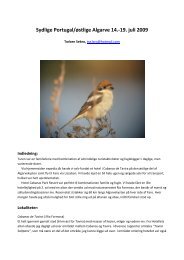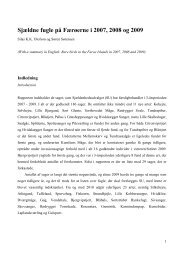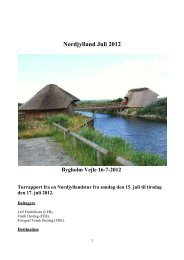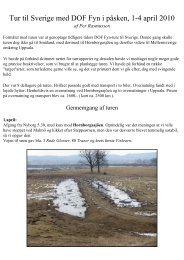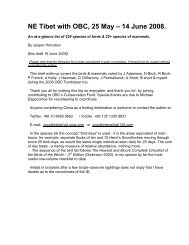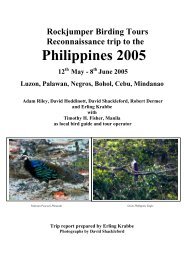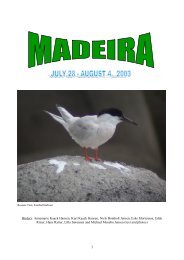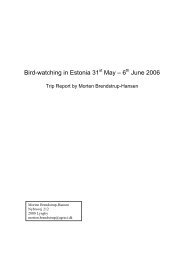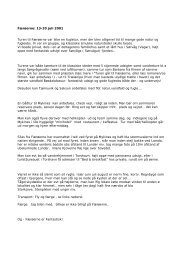TURKEY - a report from a birdwatching trip to Central ... - Netfugl.dk
TURKEY - a report from a birdwatching trip to Central ... - Netfugl.dk
TURKEY - a report from a birdwatching trip to Central ... - Netfugl.dk
You also want an ePaper? Increase the reach of your titles
YUMPU automatically turns print PDFs into web optimized ePapers that Google loves.
223. Cetti´s Warbler Cettia cetti Cettisanger<br />
2005: 13.5 1 Cucurbak - 16.5 7 Gelinkaya - 21.5 3 marshes along Euphrates south of Birezik - 23.5<br />
2 Göksu Delta.<br />
2006: 18.5 1 Gö<strong>dk</strong>er – 18.5 6 Gelinkaya – 18.5 1 Maden Köprubasi – 23.5 1 Van-Tatvan – 24.5 2<br />
Birezik.<br />
2007: 15.51 Camardi – 17.5 4 Sarkisla-Sivas – 17.5 1 Sivas-Kizilham Gecedi – 17.5 2 Kizilham<br />
Gecedi-Erzinzan – 18.5 2 Altunkent-Askale- 18.5 4 Gelinkaya – 18.5 2 Yoncalic-Maden Köprubasi<br />
– 18.5 3 Maden Köprubasi – 21.5 2 Bendimahi, Van Gölü – 22.5 1 Tatvan-Baykan – 23.5 1 Karadut<br />
– 24.5 2 Hotel Euphrates, Karadut – 24.5 1 Karadut – 25.5 1 Birezik – 25.5 1 Birezik-Halfeti.<br />
224. Sedge Warbler Achrcephalus schoenebaenus Sivsanger<br />
2005: 19.5 3 Erzek Gölü - 20.5 1 South van Marshes.<br />
2006: 21.5 1 Kars – 22-23.5 daily max. 10 South Van Marshes, Van.<br />
2007: 18.5 1 Rize (migrating bird, hitting a window at the hotel restaurantbefore settling off after<br />
recovering!) – 20.5 2 Ardahan – 24.5 4 Grael Pits, Birezik.<br />
225. Moustached Warbler Acrocephalus melanopogon Tamarisksanger<br />
2007: 14.5 1 Akgöl, Göksu Delta – 16.5 3 Seniköy, Sultan Sazligi – 25.5 1 River Euphrates S of<br />
Birezik.<br />
Scarce breeder, found in reed-beeds and lake-shores, canals etc, where open water intermix with<br />
extensive vegetation. Traditional sites areGöksu Delta, Sultan Sazligi (especially the canal along the<br />
road east of Ovaciftlik, at Seniköy (site 6 in Gosney 1991), Erzek Gölü (incl. small marsh south of<br />
the main road) and reed beeds along the shores of Van Gölu, especially in the south.<br />
226. Reed Warbler Acrocephalus scirpaceus fuscus Rørsanger<br />
Common in reed beeds and well vegetated lake-sides throughout.<br />
2005: Most noted 13.5 15 Göksu Delta - 15.5 7 Sultan Marshes - 19.5 5 Erzek Gölü - 20.5 6 South<br />
Van Marshes - 21.5 9 Eufrat south of Birezik - 24,5 10 Tarsus West Delta.<br />
2006: 14.5 3 Göksu Delta – 22-23.5 daily max. 3 South Van Marshes – 24.5 1 Birezik – 25.5 14<br />
Birezik.<br />
2007: 14.5 25 Akgöl, Göksu Delta – 15.5 10 Göksu Delta – 16.5 20 Sultan Sazligi – 21.5 20 Sim Er<br />
Hotel, Dogubayazit – 21.5 10 Bendimahi - 24.5 10 gravel pits, Birezik – 25.5 50 River Euphrates S<br />
of Birezik – 26.5 20 gravel pits, Birezik – 26.5 8 Havutlu – 26.5 2 Tuzla Gölü-Adana.<br />
The ssp. fuscus is averagely less warm tinged in upperparts than scirpaceus with sandy rump,<br />
sometimes hardly differing <strong>from</strong> greyish-brown upperparts. The underside is averagely paler with at<br />
most slightly yellowish-buff suffusion <strong>to</strong> underparts (warmer buffish in scirpaceus), and the<br />
primaries generally more contrasting pale edges than scirpaceus (the latter maybe caused by<br />
generally later primary moult in winter (Dunn 2001), and thus looks intermediate between Reed and<br />
March Warbler. Many birds showed a contrasting greyer hindneck, at most rare in scirpaceus and<br />
Marsh Warbler There is a good deal of individual variation, with fuscus-looking birds frequently<br />
observed in Northern Europe, but we did not observe any as warm-looking in Turkey than the<br />
majority of scirpaceus <strong>from</strong> Northern Europe. Scirpaceus breeds in western part of Turkey, but<br />
wihin the range visited on out <strong>trip</strong>, the majority will show characters of fuscus. Certain birds <strong>from</strong><br />
western part of the range (Göksu, Sultan Sazligi) has slightly warmer tinge <strong>to</strong> upperparts and flanks,<br />
matching scirpaceus (Roselaar 1995, Pearson et al. 2002, own obs.).<br />
Establishing this taxon <strong>to</strong> a species of its own, as proposed by the Dutch CSNA is a very optimistic<br />
treatmens of a taxon, which even DNA-wise does not differ that much <strong>from</strong> its look-alike!




